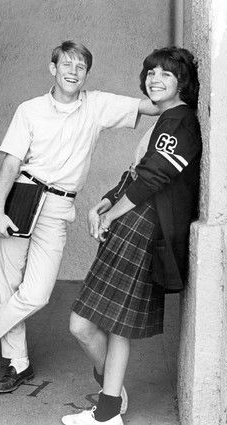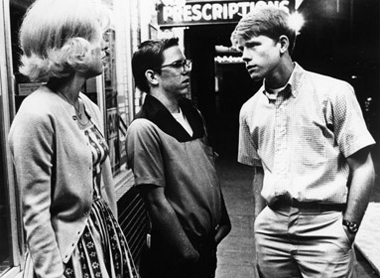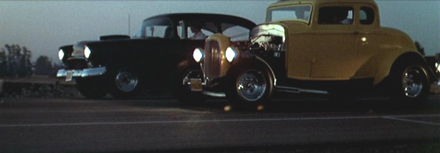
 |
|
|
|
George Lucas' comedy American Graffiti is by far his best-written and most enjoyable picture, and perhaps the only one with a consistent sense of humor. There really is no other movie by anybody that captures the particular 'in between' years after the death of Buddy Holly (an event unknown to me, at age 8) and the arrival of The Beatles, an Earth-shattering event for a kid of 12. In August of 1960 I moved to San Bernardino, California, a car town where the big activity was to find some way, any way, to sneak behind the wheel of a car. When I finally could drive on my own I couldn't take my father's Mustang out on a weekend night -- I'd be challenged to drag race by guys not very different from Bob Falfa, complete with "Ain't he neat?" girl accessories by their sides. San Berdoo was also a big, big AM radio market, with two competing Rock 'n' Roll stations. The airwaves in 1963 overflowed with pop music, almost all of which seemed to be one-of-a-kind novelty songs, each with a different "sound". Although we couldn't receive Wolfman Jack, his legend was present, and the stations we listened to (my favorite was KMEN 129) were highly interactive. 
When American Graffiti arrived, I can say that most people my age experienced their first blast of genuine nostalgia. Like Faye Dunaway's Bonnie Parker, we looked at the spectacle on screen and said, "You told my story!" As far as I was concerned, the fun and craziness of Graffiti was my personal experience, which is nonsense. But all that music ran in our blood stream ... I had heard of Gloria Katz and Willard Huyck, who 7 or 8 years before were star film students. George Lucas turned to them to help sketch the great characters of American Graffiti, something we wish he'd done for more of his later movies, as he can't write dialogue to save his soul. Katz and Huyck were making their own "cheapo horror movie", an overachieving, artsy thriller known as Messiah of Evil. The extras on that disc establish the unpromising circumstances that led to American Graffiti: a director with one rigorous but uncommercial Sci-Fi picture under his belt and writers whose "personal" horror epic was shown almost nowhere. The wonderful, insightful comic characters of American Graffiti are perhaps so perfect because the film's long gestation period gave the writers time to really think everything out. The script was finalized so close to its production date that the studio had no time to screw it up, and Lucas had no opportunity for second-guessing. The serendipity at work of course extends much farther than the script. Lucas's choice of Techniscope is rescued by Haskell Wexler's pinch-hitting to optimize images filmed in that wild format -- those poor cameramen used all their skill just to keep the actors in focus. Lucas & Co. took the time to cast the film brilliantly -- every kid face in the picture looks wonderful. Perhaps adopting the directing style of his partner- partial mentor Francis Coppola, Lucas kept the shooting loose, allowing the actors as much freedom as possible given the short schedule. The result still looks entirely fresh. We're almost surprised to see rehearsal footage of the actors reciting their lines, as so many of the performances have a "first time through" quality. I've heard complaints that the movie looks too "fifties" to be 1962, which is nonsense -- before the homogenization of media, the youth culture of every American town was at a different evolutionary stage. There were guys with ducktail hairdos and cigarettes in the sleeves of their tight T-shirts all the way into the '70s (although I avoided them!). A big surprise of American Graffiti was that somebody got those kids to cut their hair and learn to dance the way they might in '62. That was when it wasn't criminally uncool to go to a dance to actually dance, and having fun was the point even if the best you could do was a spastic twist imitation. Girls did dance in their socks, and girls too secure to be intimidated danced with girls -- often the only good dancer available was another girl. We were hugely grateful for ANY band that could play hit songs and make lots of noise -- no arbiters of taste griped at the playlist or told us that the musicians were incompetent. I wouldn't have known anyway. This was all part of the innocence. 
Some of the claims made on the very good Laurent Bouzereau docu for American Graffiti are a bit wacko (was Graffiti really the first movie to use parallel, unrelated plots?). The brilliance of the screenplay is its structural decision to pair up opposite characters. The goofball loser Terry the Toad (Charlie Martin Smith) spends the evening with the not-too-bright "fast" girl Debby (Candy Clark), while the superannuated scofflaw and drag racer John Milner (Paul Le Mat) finds himself saddled with the under-aged, precocious brat-sweetheart Carol (Mackenzie Phillips). Clean-cut college material & budding intellectual Curt (Richard Dreyfuss) is hijacked by a trio of low-riding hoodlums from the Pharaohs car club, led by the laid-back Joe (Bo Hopkins). The Homecoming Queen and the BMOC jock Laurie and Steve (Cindy Williams & Ron Howard) work out familiar teen romance issues, culminating in a potential tragedy when Laurie steps into the hot rod driven by the reckless street racing menace Bob Falfa (Harrison Ford). It's of course doubly nostalgic to see the now-familiar faces in the secondary cast, an asset that was stressed for American Graffiti's 1978 reissue that added stereo sound and restored a few minor cut scenes. By that time we had a better idea who Kathleen Quinlan, Kay Lenz, Joe Spano and Suzanne Somers were. Harrison Ford probably fell into this category too, considering that he had zoomed from unknown to superstar in the interim. Another common comment about American Graffiti is that its wall-to-wall selection of pop music cues "constitutes another character". I wouldn't go that far, but the use of a lot of songs that even by 1973 had been banished to retro oldies stations created a shock of recognition. Hearing the songs LOUD over theater speakers was unusual in itself, just as hearing Rock Around the Clock and Beatles songs blasting out in Blackboard Jungle and A Hard Day's Night had inspired kid moviegoers to spontaneously jump up and start dancing in the aisles. Beyond the tunes themselves, we'd never heard creative sound design like this before. The songs echo and distort in perspective when heard from down the block. The music reverb-echoes between plate glass windows and goes in and out of phase when a particular car radio delays the signal. A single lyric line or music riff will suddenly jump through the audio haze to be heard in the foreground. Lucas, his editors and his ace sound designer-mixer Walter Murch wrap the songs around the action. The visuals are cut to fit the meter of the music, which of course, is both a reflection of and catalyst for the action on screen. When a girl gives Curt "the look" that she's ready to be kissed in the back of a Volkswagen, the specific song playing is no accident. Of course, plenty of lyric lines are positioned to comment on the screen action, such as The Big Bopper's "Helllloooo, bayy - bee!" as Terry is confronted by a pair of oversized car thieves. These tend to be as funny (or touching) on the tenth viewing as they were on the first. The ending titles explaining the fates of the four male leads have been hit with a lot of criticism, some of which is legit -- the girls aren't afforded the same courtesy. I can vouch that there were gasps in the audience, as the one-line text bios broke the spell of the movie that went before. In terms of what happened in the second half of the decade, I think this ending is still powerful. My age group wasn't affected until the end of the '60s and a few years beyond, but George Lucas probably saw a lot of his classmates get derailed by the war, if not swallowed up by it. 
Finally, there's so much happening here that the movie gets exactly right: the adulation of the High School "celebrities", the capers in the boy's & girl's bathrooms, the many teenage boys trying to be more like Steve McQueen than the next guy. The kid behaviors are less exaggerated than they are 'compressed', with a lot of extremes crammed into the one night. American Graffiti isn't a coming of age movie, it's a anthropological thesis on mating rituals (the funny kind). Curt's exclamation, "that girl in the car! She wants me! Somebody out there wants me!" is the feeling that made all our hearts beat faster. At the big dance, look at the way Kathleen Quinlan's Peg keeps shooting smiles across at the terminally clueless Steve. Peg is too smart to openly display her feelings, but a small part of her would be overjoyed if a truck indeed wiped out Laurie, leaving the path open to her boyfriend. More typical is the poor carhop who more or less tells the desirable Steve, come over to my house and do what you want with me ... only to have Steve turn down even that desperate offer. Ex- kid star Ron Howard is perfect for the part, if you locate your senior year album and take another look at the guys you thought were Alpha Male girl magnets. They're babies and clueless dolts just like you were, maybe blessed with better looks but more likely possessed of a slightly stronger illusion of self-esteem. American Graffiti is a collection of teen legends, yet it very strongly captures the desperation of those high school years. The cumulative feeling imparted is that all this fun and immature romance will soon evaporate in the hard world of adult realities and cruel politics. Universal's Blu-ray of American Graffiti is bright, colorful, clean and sharp; I like it much better than the image on the older DVD. In short, it looks very different -- better -- than Universal's original theatrical release prints, which were fuzzy and very, very grainy. I swear, with the darker, more marginal scenes such as the pre-dawn drive to Paradise Road, the swimming patterns of grain almost overpowered the image. By going (I assume) back to the original half-frame Techniscope original, Universal's assets managers have extracted a far superior image than could be obtained through the crummy 1973 optics that blew Techniscope up to anamorphic widescreen. Just as so many web reviews of this modern classic have no clue whatsoever about what elevates it above and beyond teen comedies from any decade, I can't say that I bother to read through technically oriented reviews crying foul over the improved transfer. If the image is 'ruined' with edge enhancement, in this instance I can't see it and it doesn't bother me. Some of the reviews don't seem aware that the show was filmed in an undersized format, on film stock rated for two or three times the lighting that Lucas and Haskell Wexler used. It still looks plenty rough in darker shots, but now we see decent colors. American Graffiti had a ragged docu look, but I'd rather watch disc this than the old degraded image. And I'm fairly sure Lucas hasn't altered anything. He doesn't own this movie outright and has little to gain by "improving" it every ten years. 1 
The audio appears to be the 1978 stereo mix, which I wouldn't change either. Walter Murch (I believe it was him) really went to town, crafting a track that does everything right and might be ruined by further 'spreading out' or the addition of intrusive directional effects. Those rock 'n' roll hits sound beefier and more authentic than the 45rpm originals. The disc carries all of the excellent extras from earlier DVD editions. The long form making-of docu uses interviews with many of the original actors. Richard Dreyfuss manages to compliment himself even when saying what a klutz he was, while Harrison Ford states flat out that he'd all but given up on acting after six or seven years of near-total frustration. Suzanne Somers' part was so small, about all she can say is that the owner of the white T-Bird she drove felt nervous having her behind the wheel, even though she was a perfectly good driver. It's fun to hear Gloria Katz and Willard Huyck recall how surprised they were when American Graffiti developed into such a big deal monster hit. They knew they had something good when they wrote it, but at the time the only movies comparable to this show were A.I.P.'s Beach Party pictures. Also present is a selection of audition and rehearsal films showing the various actors trying out for their roles. The pressure on these kids seems enormous ... coming back again and again, getting their hopes up. Casting films is clearly a refined talent, as it's only in hindsight that we outsiders see how perfect these actors are. Finishing off the older extras is the original trailer, which is pretty dark but doesn't approximate the look of the original film. The new-to-disc material is formatted in Universal's "U-Control" PIP format, which doesn't work with older generation Blu-ray players. On the new commentary George Lucas goes over the same ground as the making-of docu with less enthusiasm. His image is there, but in the many gaps in the commentary we wonder why we are waiting for the director to pop up again. The Music of American Graffiti is a simple pop up track with info on the songs. It's another idea unsuited for this format, unless a lot more trivia information was included. Besides, it reminds me of the day someone reached over me in a used CD store to snatch a bargain-priced disc set of American Graffiti music from under my very nose. The scum. So your best bet is still the 80-minute Laurent Bouzereau making-of docu, which I can report I completely re-watched, even though I intended only to sample it. I'm really happy that American Graffiti has finally made it to Blu-ray.
On a scale of Excellent, Good, Fair, and Poor,
American Graffiti Blu-ray rates:
Footnotes:
1. For the '98 video iteration I believe Lucas did alter the opening shot of Mel's Diner, making it look more like sunset, and more rural -- the original location is smack in the middle of San Francisco. (I can't find the name of the reader who caught my error here...)
Reviews on the Savant main site have additional credits information and are often updated and annotated with reader input and graphics. Also, don't forget the 2010 Savant Wish List. T'was Ever Thus.
Review Staff | About DVD Talk | Newsletter Subscribe | Join DVD Talk Forum |
| ||||||||||||||||||